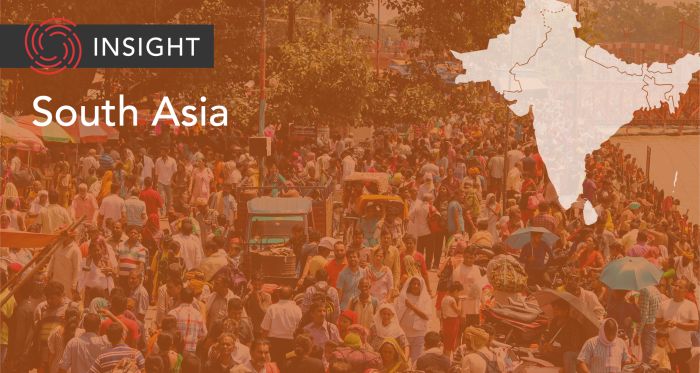The Takeaway
As India overtakes China as the world’s most populous country, it is important to consider the economic and demographic implications of India’s booming population for Canada. India’s role as a “critical partner” within Canada’s Indo-Pacific Strategy and the large Indian diaspora in Canada make it essential for Canada to cash in on its decades-long relations with the world’s largest democracy and build strong economic ties that can weather political storms.
In Brief
The UN released data in April putting India’s population at 1.4286 billion people, beating out China — with a population of 1.4257 billion — to become the world’s most populous country. The world’s largest democracy boasts a young, educated, and largely middle-class population as well as a government that is looking to fuel the country’s economic growth and prosperity in the decades to come. The population boom presents several opportunities for expanding and deepening Canada-India relations.
Implications
India’s population boom is an opportunity for both the Indian government and its foreign partners. An expanding middle class, increased consumer spending, and rising investment in digitalization, infrastructure, manufacturing, and the clean energy sector are propelling the country’s current growth. As India and Canada move towards finalizing an Early Progress Trade Agreement — a first step towards a larger free trade agreement — it is critical for Canada to recognize that India is facing pressures in terms of resources for this booming population, opening pathways for Canadian engagement in some key sectors.
The UN data shows that the bulk of the Indian population (68%) is aged 15 to 64, while Pew Research notes that 40 per cent of India’s population is under the age of 25. Even though the country faces a declining birthrate (and the possibility of political imbalances resulting from that slowing birthrate), India’s population may not peak until 2047. The country’s young people, which comprise most of India’s service sector, make up one of the largest workforces in the world, but 7.8 per cent of the demographic is currently unemployed. Therefore, it is not surprising to see the service sector as one of the key components in India’s negotiations on trade agreements.
Canada can tap into India’s talent in three main ways. First, the Indian economy has opened its doors to economic engagement that can generate employment opportunities. India is well-situated to provide relatively inexpensive labour, making manufacturing a key sector going forward. Case in point, Apple products manufacturer Foxconn has been expanding operations in India, and Apple also opened its first two retail stores in the country in April. Many of India’s highly skilled workers are English speakers, making them an attractive talent pool for the West. Second, India’s young population will require quality education support and training, a resource that will help their employability. This presents unique opportunities for Canadian universities, particularly in light of India’s National Education Policy 2020, which welcomes foreign engagement in the education sector. Third, the public health sector will likely grow in importance as the world’s largest population ages and places new stresses on health care.
But the population boom is not without its challenges. India’s middle-class consumer population has risen from 14 per cent in 2004-05 to 31 per cent in 2021, and it is expected to rise to 63 per cent of the population by 2047, making the country a seemingly attractive market for Canadian exporters. However, some observers note that India has strong domestic players who have acquired significant parts of the consumer market, including the Adani Group, Tata Group, and Reliance. The government has also introduced various “quality control” orders that Canada and other countries have labelled as protectionist measures. India is also being courted by various countries, including the U.K. and Australia, for free trade agreements and collaborations. As the competition gets fiercer, Canada will need to get some skin in the game.
What's Next
- Growing Indian diaspora in Canada
Canada is home to one of the largest overseas communities of Indian origin, with approximately 1.4 million Canadians of Indian heritage. The number of Indians who became permanent residents in Canada increased 260 per cent from 2013 to 2022, according to Immigration, Refugees and Citizenship Canada data. With Canada aiming to grant citizenship to 300,000 people in 2022-23 alone, it is important for Ottawa to leverage existing diaspora networks to establish connections with India. Furnishing Canadian MSMEs with information and logistical support to encourage trade and build up “Brand Canada,” trade missions and active engagement are all key steps to building bilateral trust and relations.
- An opportunity in India’s G20 presidency
India hosts the G20 summit this September. With multiple meetings leading up to the event, the multilateral forum for international economic co-operation will be a key opportunity for Canada and India to solidify economic relations. The increased levels of diplomatic engagements have been beacons of hope for many Canadian entrepreneurs interested in expanding to India. As many as eight Canadian cabinet ministers, in addition to Prime Minister Justin Trudeau, are expected to participate in G20 events in 2023.
• Produced by CAST's South Asia team: Dr. Sreyoshi Dey (Program Manager); Prerana Das (Analyst); Suyesha Dutta (Analyst); and Silvia Rozario (Analyst).




